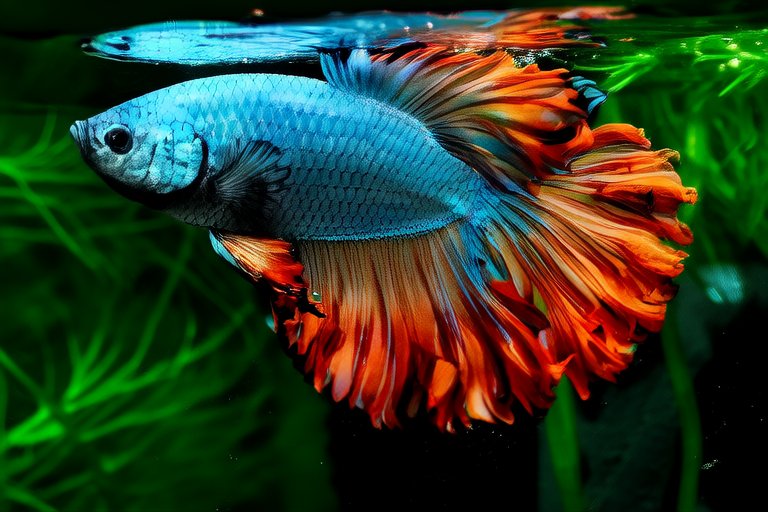Unraveling the Beauty and Behavior of Betta Fish
Welcome to a fascinating journey into the world of Betta fish, one of the most captivating and popular choices for aquarists. These fish, scientifically known as Betta splendens, are celebrated for their vibrant colors and unique physical characteristics. They are often referred to as ‘Siamese fighting fish’ due to their aggressive behavior towards other males, especially within close proximity. This article aims to unravel the beauty and behavior of Betta fish, providing a comprehensive guide for both beginners and seasoned enthusiasts.
The Vibrant Colors and Unique Physical Characteristics of Betta Fish
Betta fish are renowned for their striking colors and elegant fins. Their bodies are usually adorned with hues of blue, red, green, yellow, or black, with intricate patterns and shades that make each fish unique. The male Betta fish, in particular, have larger and more elaborate fins compared to their female counterparts. These fins can be long and flowing, resembling a delicate veil, or short and compact, depending on the breed. The tail fin, which is often the most prominent feature, can range from a classic fan shape to a double-tail or half-moon shape. These variations add to the diversity and aesthetic appeal of Betta fish, making them a favorite among aquarium enthusiasts.
Natural Habitat and Comparison with Home Aquariums
In their natural habitat, Betta fish are found in the slow-moving waters of rice paddies, canals, and floodplains across Southeast Asia. These environments are characterized by warm temperatures and low oxygen levels, prompting the development of a labyrinth organ in Betta fish. This organ allows them to breathe air directly from the surface, a unique adaptation that sets them apart from many other fish species. However, the typical home aquarium setting is quite different from their natural habitat. While home aquariums can be designed to mimic these conditions, they also present opportunities for customization and enrichment. It’s important to replicate the warm temperature (around 78°F to 80°F) and provide plenty of surface area for the fish to access oxygen. Additionally, incorporating live plants and hiding spots can create a stimulating environment that closely resembles their natural surroundings.
Behavioral Traits: Temperament and Activity Levels
Betta fish are known for their spirited demeanor, but this can vary significantly based on individual temperament and environmental factors. Generally, male Betta fish are territorial and may exhibit aggressive behavior towards other males, particularly if confined in a small space. However, they tend to be peaceful when housed alone or with non-aggressive tank mates. Female Betta fish are less aggressive and can sometimes be kept together in groups, provided ample space and hiding spots are available. Betta fish are also quite active during daylight hours, often swimming around the tank, exploring, and displaying their vibrant colors. They are curious creatures that enjoy interacting with their environment, making them a joy to watch.
Maintaining a Healthy Environment
To ensure the well-being of your Betta fish, it’s crucial to maintain a clean and balanced aquatic environment. Water quality is paramount, and regular testing for pH, ammonia, nitrite, and nitrate levels is essential. The ideal pH level for Betta fish is slightly acidic, ranging from 6.5 to 7.0. Ammonia and nitrite levels should be kept at zero, while nitrate levels should be maintained below 20 ppm. To achieve this, perform partial water changes weekly, using a high-quality water conditioner to remove harmful chemicals. Additionally, proper filtration is necessary to keep the water clean and oxygenated. A sponge filter is often recommended for Betta fish tanks, as it provides gentle filtration without causing stress to the fish.
Diet plays a significant role in the health and vitality of Betta fish. In the wild, they primarily feed on insects and insect larvae. In captivity, a varied diet consisting of high-quality flake food, pellets, and occasional treats such as frozen bloodworms or brine shrimp can help meet their nutritional needs. Feeding Betta fish once or twice daily is sufficient, ensuring that the food is consumed within a few minutes to prevent overfeeding. Overfeeding can lead to poor water quality and health issues. It’s also advisable to offer a mix of protein-rich foods and vegetables to promote a balanced diet.
Selecting appropriate tank mates for Betta fish requires careful consideration. While Betta fish can coexist peacefully with certain species, it’s important to avoid housing them with aggressive or fin-nipping fish. Good tank mates include small, non-aggressive species like neon tetras, harlequin rasboras, and ember tetras. These fish tend to stay away from the top layer of the tank where Betta fish prefer to swim. It’s crucial to research potential tank mates thoroughly and introduce them gradually to ensure compatibility.
The Bond Between Betta Fish and Their Owners
One of the most rewarding aspects of owning Betta fish is the strong bond that can develop between the fish and their owners. Many aquarists report that their Betta fish recognize them and display signs of excitement upon their arrival near the tank. This connection can be nurtured through consistent care and interaction. Regular feeding times, gentle handling, and providing enriching activities can strengthen this bond. Observing the behavior and movements of your Betta fish can become a delightful pastime, offering moments of relaxation and joy.
In conclusion, Betta fish are not only beautiful but also intriguing companions that can bring immense satisfaction to their owners. By understanding their natural habitat, behavior, and specific care requirements, you can provide a nurturing environment that promotes their health and happiness. Whether you’re a beginner or an experienced aquarist, caring for Betta fish offers a unique and fulfilling experience. Embrace the journey of unraveling the beauty and behavior of these magnificent creatures, and enjoy the rewarding relationship that develops between you and your Betta fish.
